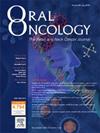Conditional survival and dynamic failure hazard of oral cavity squamous cell carcinoma: Shedding light on the optimization of treatment and surveillance
IF 4
2区 医学
Q1 DENTISTRY, ORAL SURGERY & MEDICINE
引用次数: 0
Abstract
Purpose
To provide a comprehensive analysis of conditional survival (CS) and dynamic failure hazards in oral cavity squamous cell carcinoma (OCSCC), enhancing prognostic understanding and facilitating more individualized treatment strategy and surveillance.
Method
Patients with non-metastatic OCSCC undergoing surgery between 1999 and 2018 were retrospectively analyzed. Overall survival (OS), disease-free survival (DFS), conditional OS (COS), and conditional DFS (CDFS) were calculated. Annual hazards, including death, progression, and stage-specific risks, were estimated using Kernel-based methods.
Results
Among 700 patients (median follow-up: 97.6 months), the 5-year OS and DFS were 68.3 % and 62.0 %, respectively. The 5-year COS improved from 71 % after one year to 86 % after five years, while the 5-year CDFS increased from 76 % to 87 %. Annual hazard rates for death and progression peaked in the first two years post-surgery, with death hazard declining from 9.8 % to 3.3 % and progression hazard decreasing from 20.0 % to 2.9 % by the fifth year. Stage-specific death hazards peaked at varying timings: the second year for stages I/II, the third year for stage III, and the first two years for stage IV. Progression hazards peaked in the first year for all stages, with stage IV showing the highest risk at 32.0 %, decreasing to ∼ 4 % by the fourth year.
Conclusion
This study provides an updated overview of CS and dynamic failure hazards in OCSCC, particularly emphasizing the high progression hazard in stage IV patients during the first year. These findings support tailored treatment strategies and rigorous early surveillance to improve outcomes.
口腔鳞状细胞癌的条件生存和动态衰竭危险:对优化治疗和监测的启示
目的全面分析口腔鳞状细胞癌(OCSCC)的条件生存(CS)和动态衰竭风险,提高对预后的认识,促进更个性化的治疗策略和监测。方法回顾性分析1999年至2018年接受手术治疗的非转移性OCSCC患者。计算总生存期(OS)、无病生存期(DFS)、条件生存期(COS)和条件生存期(CDFS)。使用基于核的方法估计年度风险,包括死亡、进展和阶段特异性风险。结果700例患者(中位随访97.6个月),5年OS和DFS分别为68.3%和62.0%。5年的COS从1年后的71%提高到5年后的86%,而5年的CDFS从76%提高到87%。死亡和进展的年危险率在手术后的头两年达到顶峰,死亡危险率从9.8%下降到3.3%,到第5年,进展危险率从20.0%下降到2.9%。特定阶段的死亡危险在不同的时间达到顶峰:第一年为I/II期,第三年为III期,头两年为IV期。所有阶段的进展危险在第一年达到顶峰,其中IV期的风险最高,为32.0%,到第四年降至4%。本研究提供了OCSCC中CS和动态衰竭风险的最新概述,特别强调了IV期患者在第一年的高进展风险。这些发现支持量身定制的治疗策略和严格的早期监测,以改善结果。
本文章由计算机程序翻译,如有差异,请以英文原文为准。
求助全文
约1分钟内获得全文
求助全文
来源期刊

Oral oncology
医学-牙科与口腔外科
CiteScore
8.70
自引率
10.40%
发文量
505
审稿时长
20 days
期刊介绍:
Oral Oncology is an international interdisciplinary journal which publishes high quality original research, clinical trials and review articles, editorials, and commentaries relating to the etiopathogenesis, epidemiology, prevention, clinical features, diagnosis, treatment and management of patients with neoplasms in the head and neck.
Oral Oncology is of interest to head and neck surgeons, radiation and medical oncologists, maxillo-facial surgeons, oto-rhino-laryngologists, plastic surgeons, pathologists, scientists, oral medical specialists, special care dentists, dental care professionals, general dental practitioners, public health physicians, palliative care physicians, nurses, radiologists, radiographers, dieticians, occupational therapists, speech and language therapists, nutritionists, clinical and health psychologists and counselors, professionals in end of life care, as well as others interested in these fields.
 求助内容:
求助内容: 应助结果提醒方式:
应助结果提醒方式:


